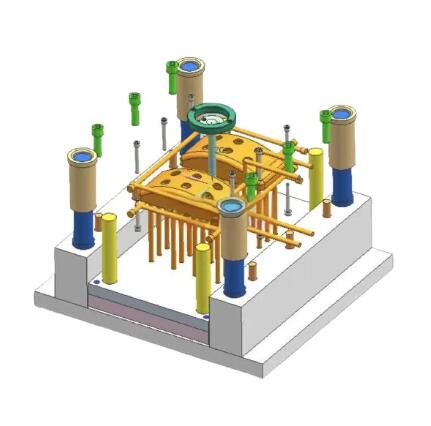The Evolution from 2D to 3D Drawings in Modern Mold Design
2024-09-05
Mold design has evolved significantly over the years, with advances in technology leading to more efficient and precise design processes. One of the most significant shifts in this field is the transition from 2D drawings to 3D modeling. While 2D drawings have been a staple in mold design for decades, the rise of 3D technologies has introduced new possibilities for innovation, efficiency, and accuracy. In this blog, we’ll explore how the move from 2D to 3D has transformed mold design and what this evolution means for the future of manufacturing.
The Traditional Role of 2D Drawings in Mold Design
For much of the history of mold design, 2D drawings have been the primary method for representing mold structures. Engineers would create detailed 2D blueprints showing top, front, and side views of the mold, including dimensions, materials, and assembly instructions. These drawings served as the foundation for manufacturing, guiding machinists and toolmakers in creating each mold component.
In the traditional workflow, 2D drawings were used for:
- Specifying part details: Designers would annotate the drawings with precise measurements and tolerances to ensure that the mold components fit together correctly.
- Creating cutting paths for machining: 2D drawings were often converted into machine code for CNC milling and drilling operations.
- Quality control: Inspectors would use 2D drawings as a reference to verify that the final mold met the intended design specifications.
While 2D drawings were effective for many years, they had limitations, especially when it came to complex geometries and intricate mold designs. As the demands of modern manufacturing increased, the need for more advanced design tools became apparent.
The Rise of 3D Modeling in Mold Design
With the advent of 3D modeling software, mold design took a significant leap forward. 3D models offer a three-dimensional representation of the mold, allowing designers to visualize every aspect of the mold’s geometry and function. This shift from 2D to 3D has had a profound impact on the mold design process, making it faster, more accurate, and more efficient.
Key advantages of 3D modeling in mold design include:
- Comprehensive visualization: Unlike 2D drawings, which only show flat views, 3D models provide a full representation of the mold, enabling designers to rotate and manipulate the design for a complete understanding of its shape and structure.
- Enhanced communication: 3D models are easier to interpret and share across teams, making collaboration between design, engineering, and manufacturing more seamless.
- Simulation and testing: With 3D models, designers can simulate the molding process, testing how materials flow through the mold and identifying potential issues such as warping or air pockets before production begins.
The Shift from 2D to 3D: Benefits and Challenges
The transition from 2D drawings to 3D modeling has brought numerous benefits to the mold design process, but it has also introduced some challenges. Let’s take a closer look at the pros and cons of this evolution.
Benefits of 3D Modeling
1. Increased Accuracy: With 3D models, designers can create highly detailed and accurate representations of the mold, reducing the risk of errors and misinterpretations. The ability to see the entire mold in 3D ensures that all components fit together properly.
2. Improved Efficiency: 3D models streamline the design process, allowing engineers to make adjustments quickly and easily. Changes to the design can be made in real time, with the model automatically updating to reflect the changes.
3. Faster Prototyping and Manufacturing: 3D models can be directly used for CNC machining, 3D printing, and other automated manufacturing processes. This reduces the time needed to create prototypes and speeds up the production timeline.
4. Cost Savings: By identifying potential issues during the design phase, 3D modeling helps prevent costly errors during production. Simulations and virtual testing allow designers to refine the mold before any physical materials are used, reducing waste and rework.
Challenges of Transitioning to 3D
1. Software and Training Costs: Implementing 3D modeling in a design process requires specialized software, such as CAD (Computer-Aided Design) programs, as well as training for designers and engineers. The initial investment can be significant for some companies.
2. Learning Curve: For designers accustomed to working with 2D drawings, there is a learning curve when transitioning to 3D modeling. Mastering the tools and features of 3D software can take time and effort.
3. Complexity in Design: While 3D models offer more flexibility, they can also introduce complexity. Designers must ensure that they use the tools correctly to avoid creating overly complicated models that are difficult to manufacture.
The Future of Mold Design: 3D Printing and Beyond
As mold design continues to evolve, 3D printing is emerging as a powerful tool for both prototyping and production. By integrating 3D models with 3D printing technology, manufacturers can create rapid prototypes of molds, test them, and refine the designs in a fraction of the time it would take using traditional methods.
In the future, the combination of 3D modeling, simulation, and additive manufacturing will likely drive even more innovation in mold design. Advanced simulation tools will enable designers to predict how materials will behave in real-world conditions, leading to smarter, more efficient molds. At the same time, 3D printing will allow for the creation of highly customized molds that are tailored to specific production needs.
Conclusion
The shift from 2D to 3D modeling has transformed the field of mold design, offering new opportunities for accuracy, efficiency, and innovation. While 2D drawings still play a role in documenting and communicating certain aspects of mold design, 3D models are becoming the industry standard for complex mold projects. As technology continues to advance, the future of mold design will be shaped by the integration of 3D modeling, simulation, and additive manufacturing techniques, leading to smarter, faster, and more cost-effective production processes.



